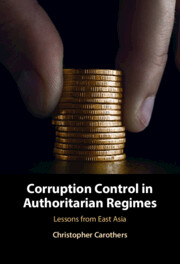Book contents
- Corruption Control in Authoritarian Regimes
- Corruption Control in Authoritarian Regimes
- Copyright page
- Contents
- Figures
- Tables
- Acknowledgments
- 1 Introduction
- 2 Theory and Methodology
- 3 How the Kuomintang Cleaned House in Taiwan
- 4 Corruption Control in Authoritarian South Korea
- 5 The Chinese Communist Party’s War against Corruption, 1921–1990
- 6 Xi Jinping’s Campaign and the End of Political Liberalization
- 7 Anti-corruption Efforts around the Authoritarian World
- 8 Conclusion
- Book part
- Bibliography
- Index
2 - Theory and Methodology
Published online by Cambridge University Press: 31 March 2022
- Corruption Control in Authoritarian Regimes
- Corruption Control in Authoritarian Regimes
- Copyright page
- Contents
- Figures
- Tables
- Acknowledgments
- 1 Introduction
- 2 Theory and Methodology
- 3 How the Kuomintang Cleaned House in Taiwan
- 4 Corruption Control in Authoritarian South Korea
- 5 The Chinese Communist Party’s War against Corruption, 1921–1990
- 6 Xi Jinping’s Campaign and the End of Political Liberalization
- 7 Anti-corruption Efforts around the Authoritarian World
- 8 Conclusion
- Book part
- Bibliography
- Index
Summary
Chapter 2 covers theory and methodology. In the theory section, I elaborate on the conventional wisdom about authoritarian corruption control, consider several alternative explanations, and then present my argument in full. In the methodology section, I develop my proposed scoring system for anti-corruption efforts, describe how political factors such as discretionary power are assessed, defend my case selection, and give a brief overview of the sources used.
Keywords
- Type
- Chapter
- Information
- Corruption Control in Authoritarian RegimesLessons from East Asia, pp. 17 - 47Publisher: Cambridge University PressPrint publication year: 2022

